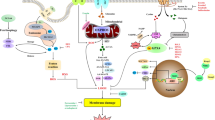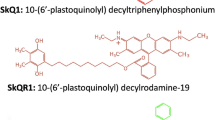Abstract
Dysregulated apoptotic cell death contributes to many pathological conditions, including sepsis, prompting the suggestion that caspase inhibition to block apoptosis could have useful therapeutic applications. Because the cytokine tumor necrosis factor (TNF, also known as TNF-α) is both pro-apoptotic and pro-inflammatory and is involved in septic shock, we tested whether caspase inhibition would alleviate TNF-induced toxicity in vivo. General caspase inhibition by the protease inhibitor zVAD-fmk exacerbated TNF toxicity by enhancing oxidative stress and mitochondrial damage, resulting in hyperacute hemodynamic collapse, kidney failure and death. Thus, survival of TNF toxicity depends on caspase-dependent processes. Our results demonstrated the pathophysiological relevance of caspase-independent, ROS-mediated pathways in response to lethal TNF-induced shock in mice. In addition, survival of TNF toxicity seemed to require a caspase-dependent protective feedback on excessive reactive oxygen species (ROS) formation and phospholipase A2 activation.
This is a preview of subscription content, access via your institution
Access options
Subscribe to this journal
Receive 12 print issues and online access
$209.00 per year
only $17.42 per issue
Buy this article
- Purchase on Springer Link
- Instant access to full article PDF
Prices may be subject to local taxes which are calculated during checkout






Similar content being viewed by others
References
Ayala, A., Lomas, J.L., Grutkoski, P.S. & Chung, C.S. Pathological aspects of apoptosis in severe sepsis and shock? Int. J. Biochem. Cell Biol. 35, 7–15 (2003).
Krammer, P.H. CD95's deadly mission in the immune system. Nature 407, 789–795 (2000).
Bilsland, J. & Harper, S. Caspases and neuroprotection. Curr. Opin. Investig. Drugs 3, 1745–1752 (2002).
Hengartner, M.O. The biochemistry of apoptosis. Nature 407, 770–776 (2000).
Leist, M. & Jaattela, M. Four deaths and a funeral: from caspases to alternative mechanisms. Nat. Rev. Mol. Cell Biol. 2, 589–598 (2001).
Baud, V. & Karin, M. Signal transduction by tumor necrosis factor and its relatives. Trends Cell. Biol. 11, 372–377 (2001).
Vercammen, D. et al. Inhibition of caspases increases the sensitivity of L929 cells to necrosis mediated by tumor necrosis factor. J. Exp. Med. 187, 1477–1485 (1998).
Fiers, W., Beyaert, R., Declercq, W. & Vandenabeele, P. More than one way to die: apoptosis, necrosis and reactive oxygen damage. Oncogene 18, 7719–7730 (1999).
Schulze-Osthoff, K. et al. Cytotoxic activity of tumor necrosis factor is mediated by early damage of mitochondrial functions. Evidence for the involvement of mitochondrial radical generation. J. Biol. Chem. 267, 5317–5323 (1992).
O'Donnell, V.B., Spycher, S. & Azzi, A. Involvement of oxidants and oxidant-generating enzyme(s) in tumour-necrosis-factor-α-mediated apoptosis: role for lipoxygenase pathway but not mitochondrial respiratory chain. Biochem. J. 310, 133–141 (1995).
Künstle, G. et al. ICE-protease inhibitors block murine liver injury and apoptosis caused by CD95 or by TNF-α. Immunology Letters 55, 5–10 (1997).
Piguet, P.F., Vesin, C., Guo, J., Donati, Y. & Barazzone, C. TNF-induced enterocyte apoptosis in mice is mediated by the TNF receptor 1 and does not require p53. Eur. J. Immunol. 28, 3499–3505 (1998).
Piguet, P.F., Vesin, C., Donati, Y. & Barazzone, C. TNF-induced enterocyte apoptosis and detachment in mice: induction of caspases and prevention by a caspase inhibitor, ZVAD-fmk. Lab. Invest. 79, 495–500 (1999).
Rodriguez, I., Matsuura, K., Ody, C., Nagata, S. & Vassalli, P. Systemic injection of a tripeptide inhibits the intracellular activation of CPP32-like proteases in vivo and fully protects mice against Fas-mediated fulminant liver destruction and death. J. Exp. Med. 184, 2067–2072 (1996).
Jaeschke, H. et al. Activation of caspase 3 (CPP32)-like proteases is essential for TNF-α-induced hepatic parenchymal cell apoptosis and neutrophil-mediated necrosis in a murine endotoxin shock model. J. Immunol. 160, 3480–3486 (1998).
Ameloot, P. et al. Bioavailability of recombinant tumor necrosis factor determines its lethality in mice. Eur. J. Immunol. 32, 2759–2765 (2002).
Schotte, P., Declercq, W., Van Huffel, S., Vandenabeele, P. & Beyaert, R. Non-specific effects of methyl ketone peptide inhibitors of caspases. FEBS Lett. 442, 117–121 (1999).
Yamashita, K. et al. Caspases mediate tumor necrosis factor-α-induced neutrophil apoptosis and downregulation of reactive oxygen production. Blood 93, 674–685 (1999).
Pollock, J.D. et al. Mouse model of X-linked chronic granulomatous disease, an inherited defect in phagocyte superoxide production. Nat. Genet. 9, 202–209 (1995).
Li, Y. & Trush, M.A. Diphenyleneiodonium, an NAD(P)H oxidase inhibitor, also potently inhibits mitochondrial reactive oxygen species production. Biochem. Biophys. Res. Commun. 253, 295–299 (1998).
Rosenthal, M.D., Vishwanath, B.S. & Franson, R.C. Effects of aristolochic acid on phospholipase A2 activity and arachidonate metabolism of human neutrophils. Biochim. Biophys. Acta 1001, 1–8 (1989).
Denson, D.D., Wang, X., Worrell, R.T., AlKhalili, O. & Eaton, D.C. Cytosolic phospholipase A2 is required for optimal ATP activation of BK channels in GH(3) cells. J. Biol. Chem. 276, 7136–7142 (2001).
Worrell, R.T., Bao, H.F., Denson, D.D. & Eaton, D.C. Contrasting effects of cPLA2 on epithelial Na+ transport. Am. J. Physiol. Cell Physiol. 281, C147–C156 (2001).
Adam-Klages, S. et al. Caspase-mediated inhibition of human cytosolic phospholipase A2 during apoptosis. J. Immunol. 161, 5687–5694 (1998).
Luschen, S., Ussat, S., Kronke, M. & Adam-Klages, S. Cleavage of human cytosolic phospholipase A2 by caspase-1 (ICE) and caspase-8 (FLICE). Biochem. Biophys. Res. Commun. 253, 92–98 (1998).
Cauwels, A. et al. Protection against TNF-induced lethal shock by soluble guanylate cyclase inhibition requires functional inducible nitric oxide synthase. Immunity 13, 223–231 (2000).
Atsumi, G. et al. Fas-induced arachidonic acid release is mediated by Ca2+-independent phospholipase A2 but not cytosolic phospholipase A2, which undergoes proteolytic inactivation. J. Biol. Chem. 273, 13870–13877 (1998).
Kronke, M. & Adam-Klages, S. Role of caspases in TNF-mediated regulation of cPLA(2). FEBS Lett. 531, 18–22 (2002).
Kelliher, M.A. et al. The death domain kinase RIP mediates the TNF-induced NF-κB signal. Immunity 8, 297–303 (1998).
Holler, N. et al. Fas triggers an alternative, caspase-8-independent cell death pathway using the kinase RIP as effector molecule. Nat. Immunol. 1, 489–495 (2000).
Lin, Y., Devin, A., Rodriguez, Y. & Liu, Z.G. Cleavage of the death domain kinase RIP by caspase-8 prompts TNF-induced apoptosis. Genes Dev. 13, 2514–2526 (1999).
Vanden Berghe, W. et al. Signal transduction by tumor necrosis factor and gene regulation of the inflammatory cytokine interleukin-6. Biochem. Pharmacol. 60, 1185–1195 (2000).
Beyaert, R., Van Loo, G., Heyninck, K. & Vandenabeele, P. Signaling to gene activation and cell death by tumor necrosis factor receptors and Fas. Int. Rev. Cytol. 214, 225–272 (2002).
Schoonbroodt, S. & Piette, J. Oxidative stress interference with the nuclear factor-κB activation pathways. Biochem. Pharmacol. 60, 1075–1083 (2000).
Kawahara, A., Ohsawa, Y., Matsumura, H., Uchiyama, Y. & Nagata, S. Caspase-independent cell killing by Fas-associated protein with death domain. J. Cell Biol. 143, 1353–1360 (1998).
Foghsgaard, L. et al. Cathepsin B acts as a dominant execution protease in tumor cell apoptosis induced by tumor necrosis factor. J. Cell. Biol. 153, 999–1010 (2001).
Luschen, S., Ussat, S., Scherer, G., Kabelitz, D. & Adam-Klages, S. Sensitization to death receptor cytotoxicity by inhibition of fas-associated death domain protein (FADD)/caspase signaling. Requirement of cell cycle progression. J. Biol. Chem. 275, 24670–24678 (2000).
Zheng, T.S. et al. Deficiency in caspase-9 or caspase-3 induces compensatory caspase activation. Nat. Med. 6, 1241–1247 (2000).
Henshall, D.C., Skradski, S.L., Bonislawski, D.P., Lan, J.Q. & Simon, R.P. Caspase-2 activation is redundant during seizure-induced neuronal death. J. Neurochem. 77, 886–895 (2001).
Foghsgaard, L., Lademann, U., Wissing, D., Poulsen, B. & Jaattela, M. Cathepsin B mediates tumor necrosis factor-induced arachidonic acid release in tumor cells. J. Biol. Chem. 277, 39499–39506 (2002).
Rothe, J. et al. Mice lacking the tumour necrosis factor receptor 1 are resistant to TNF-mediated toxicity but highly susceptible to infection by Listeria monocytogenes. Nature 364, 798–802 (1993).
Erickson, S.L. et al. Decreased sensitivity to tumour-necrosis factor but normal T-cell development in TNF receptor-2–deficient mice. Nature 372, 560–563 (1994).
Van Snick, J. et al. Purification and NH2-terminal amino acid sequence of a T-cell-derived lymphokine with growth factor activity for B-cell hybridomas. Proc. Natl. Acad. Sci. USA 83, 9679–9683 (1986).
Green, L.C. et al. Analysis of nitrate, nitrite, and [15N]nitrate in biological fluids. Anal. Biochem. 126, 131–138 (1982).
Acknowledgements
This research was supported by grants from the Fonds voor Wetenschappelijk Onderzoek-Vlaanderen and the Interuniversitaire Attractiepolen. A.C. is a postdoctoral fellow with the FWO-Vlaanderen. We thank A. Raeymaekers and F. Duerinck for purifying TNF, E. Rogge and J. Hostens for help with immunoblotting and statistics, respectively, L. Van Geert, E. Spruyt and T. Hauttekeete for animal care, J. Debets for his preparation of mice in the hemodynamic studies and K. Vleminckx for critical reading of the manuscript.
Author information
Authors and Affiliations
Corresponding author
Ethics declarations
Competing interests
The authors declare no competing financial interests.
Rights and permissions
About this article
Cite this article
Cauwels, A., Janssen, B., Waeytens, A. et al. Caspase inhibition causes hyperacute tumor necrosis factor–induced shock via oxidative stress and phospholipase A2. Nat Immunol 4, 387–393 (2003). https://doi.org/10.1038/ni914
Received:
Accepted:
Published:
Issue Date:
DOI: https://doi.org/10.1038/ni914
This article is cited by
-
Rubicon-deficiency sensitizes mice to mixed lineage kinase domain-like (MLKL)-mediated kidney ischemia-reperfusion injury
Cell Death & Disease (2022)
-
Estrogen alleviates hepatocyte necroptosis depending on GPER in hepatic ischemia reperfusion injury
Journal of Physiology and Biochemistry (2022)
-
Antioxidant and food additive BHA prevents TNF cytotoxicity by acting as a direct RIPK1 inhibitor
Cell Death & Disease (2021)
-
Immunological consequences of kidney cell death
Cell Death & Disease (2018)
-
Regulated necrosis: disease relevance and therapeutic opportunities
Nature Reviews Drug Discovery (2016)



